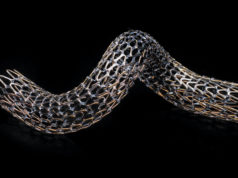
Balloon angioplasty has been utilised in lower extremity revascularisation procedures since the 1970s, but the durability of this technique is limited by both mechanical and biological forces acting on the vessel. Operators have sought to limit the effect of vessel recoil, dissections, and compressive forces of residual plaque burden with the off-label use of nitinol stents initially designed for the biliary system, and primary patency data support their use over angioplasty alone.1–3
However, it is becoming increasingly evident that the design and inherent properties of nitinol stents likely contribute to their modes of failure in lower extremity interventions. First-generation superficial femoral artery stents are laser-cut from straight nitinol tubes, and this inherently limits their flexibility and ability to handle torsion, axial load, and kinking. As a result, stent fractures are common and ultimately lead to patency loss.2,4 Additionally, stent oversizing, which is required to attain adequate radial strength, results in chronic outward radial force, and this may serve as a trigger for inflammation and intimal hyperplasia.5 Once these problems of stent fractures and in-stent restenosis occur, retreatment by endovascular means becomes increasingly complicated.
Two next-generation stents with novel designs that may address some of these issues are the Supera stent (Abbott Vascular) and the recently-approved Tigris stent (Gore). The Supera stent is comprised of six interwoven nitinol wires, giving it a unique degree of flexibility while maintaining a compression resistance that is approximately four times greater than laser-cut nitinol stents. Additionally, this stent is sized 1:1 with the vessel diameter and results in minimal chronic outward radial force, a feature that may limit vessel inflammation.
The SUPERB trial was a single-arm investigational device exemption (IDE) trial in which the Supera stent demonstrated a 12-month primary patency of 86.3% and a three-year freedom from target lesion revascularisation (TLR) of 82%. This trial included 264 patients with a mean lesion length of 78mm in whom 73% had moderate or severe calcification.6–7 Optimal results with this stent are dependent on stent deployment length, as those patients in whom the stent was deployed to intended length had a 12-month primary patency of 90.5%, while elongation of the stent was associated with a drop in patency rate and higher TLR rates.
The Tigris stent is comprised of a nitinol wire scaffold covered with a heparin-bonded PTFE coating, giving it excellent flexibility with anti-thrombotic properties. In the TIGRIS randomised trial, Tigris was randomised 3:1 against Lifestent (Bard) in 274 patients followed to 24 months. Mean lesion length in the Tigris group was 107mm with 42.1% total occlusions, and this group showed no stent fractures at two years, compared to 33% fracture rate in the Lifestent group. Surprisingly, the superior fracture resistance of the Tigris stent did not translate to a patency advantage, as the two groups had statistically equivalent primary patency at two years (57% vs. 50.2% for Tigris and Lifestent, respectively).6 Further subgroup analysis may ultimately determine whether specific lesion types or locations are best treated with this new device and whether use of Tigris over other first-generation devices is justified based on differences in patency and TLR rates.
In addition to the mechanical forces that act to reduce patency in femoropopliteal interventions, the biological phenomenon of intimal hyperplasia remains an important challenge to the long-term durability of our endovascular procedures. While scaffold design may impact restenosis by reducing such factors as chronic outward radial force, intuitively we can appreciate that reduction of intimal hyperplasia requires a biological solution, such as the delivery of antiproliferative drug therapy at the time of intervention. This strategy has now been employed with the use of both drug-coated balloons (DCBs) and drug-eluting stents (DES), and the results are promising but limitations of these devices still exist.
The LEVANT II and IN.PACT SFA trials have demonstrated the superiority of DCBs over plain balloon angioplasty.7–8 While these results have introduced DCBs into routine clinical practice, the relatively short lesion lengths (6.2cm and 8.9cm) in these randomised controlled trials may limit the applicability of these data to real-world populations. Although data from the IN.PACT Global Registry long lesion cohort support DCB use in longer lesions with 91.1% primary patency at one year with mean lesion length of 26.4cm, it is important to note the 40.4% bailout stent rate in this cohort, implying that complex lesions will continue to frequently require scaffold implantation.9
The continued need for scaffolds in complex anatomy questions whether the ideal combination may be a scaffold in conjunction with antirestenotic therapy. The first such combination device available in the USA was the Zilver PTX (Cook Medical) drug-eluting stent, and five-year outcomes have now been reported for this device.10 Outcomes with this device are favourable, with one-year and five-year primary patency rates of 83% and 66%, respectively. However, inherent limitations of the stent design include the multiple disadvantages of laser-cut nitinol stents and the lack of a polymer coating to allow for sustained drug delivery over time.
Another combination therapy currently under evaluation is the Eluvia stent (Boston Scientific), which adds a polymer coating to the antiproliferative drug. Like Zilver PTX, Eluvia uses a laser-cut nitinol stent as its scaffold platform, and thus may have similar limitations as other first-generation nitinol stents, but the polymer coating aids in slow, consistent drug delivery and may further reduce intimal hyperplasia. The MAJESTIC trial is a small single-arm evaluation of this device (in 57 patients with mean femoropopliteal lesion length of 7.1cm) which demonstrated a 12-month primary patency rate of 96.1%, although there was a notable drop at 24 months down to 78.2%.11 Further investigation of this device is ongoing in the IMPERIAL trial, which has begun enrolment and will randomise 485 patients in a 2:1 fashion against Zilver PTX.
Both Zilver PTX and Eluvia use a standard laser-cut nitinol stent as their scaffold, and this fact suggests that these devices may be subject to stent fractures, kinking, poor-compression resistance, and other complications caused by the dynamic properties of the superficial femoral artery. A novel device that combines the biomimetic properties of next-generation stents with antiproliferative therapy may be an answer to this clinical conundrum, but such a device is yet to be commercially available or even studied in clinical trials. However, another novel strategy that has been evaluated combines a bioresorbable scaffold with antiproliferative drug delivery. This combination allows for mechanical support to treat dissections and vessel recoil acutely, followed by subsequent scaffold resorption, thus removing a source of chronic irritation and preventing such issues as stent fractures. Additionally, the combination of this type of scaffold with an antiproliferative drug would help mitigate development of intimal hyperplasia. While no such device is yet approved for infrainguinal interventions or in current clinical trials, a small single-arm study has evaluated the Espirit bioresorbable vascular scaffold (Abbott Vascular) in the iliacs and superficial femoral artery.12–13 Furthermore, the Absorb GT1 bioresorbable vascular scaffold (Abbott Vascular), which is commercially available for coronary indications, has been studied in an off-label fashion for infrageniculate disease with extremely promising results.14
The ESPRIT I trial consisted of Esprit bioresorbable vascular scaffold implantation in 35 patients with iliac or superficial femoral artery disease, with a mean lesion length of 3.6cm.12 This device is a balloon-expandable stent comprised of a bioresorbable poly-L-lactide (PLLA) scaffold coated with a bioresorbable polymer/antiproliferative drug (everolimus) combination. After providing early vessel support and drug elution, the structural mass is resorbed over time allowing the vessel to regain vasomotor function. Twelve-month outcomes in the ESPRIT I trial demonstrated an 87.1% freedom from binary restenosis and 91.2% freedom from TLR, and recently presented three-year data at VIVA 2016 (18–22 September, Las Vegas, USA) demonstrated a sustained freedom from TLR of 88.1% between the two- and three-year time points.13
The Absorb GT1 bioresorbable vascular scaffold has been studied extensively in the coronary circulation and has recently obtained FDA approval for coronary interventions. This device shares the PLLA scaffold and everolimus/bioresorbable polymer properties of the Esprit bioresorbable vascular scaffold stent, but is available in diameters that are appropriate for the coronary circulation and potentially applicable for tibial interventions. The extremely high rate of restenosis in tibial interventions, combined with the general unwillingness of surgeons and interventionalists to place permanent implants in potential tibial bypass targets, makes a temporary drug-eluting scaffold as an adjunct to angioplasty of the infrageniculate circulation an attractive treatment option. Varcoe and colleagues have studied the Absorb GT1 in 38 limbs in 33 patients, placing 55 scaffolds to treat 43 lesions, with a mean length of 1.9cm. Kaplan-Meier estimates of primary patency at 12 and 24 months were 96% and 84.6%, respectively, and freedom from clinically-driven TLR at two years was 96%.14 While these lesions were admittedly short compared to most critical limb ischaemia patients, one- and two-year primary patency rates of 85–95% in the tibial circulation vastly exceed historical results, and thus these results are quite encouraging.
In conclusion, considerable progress in stent design has occurred in the past decade, and we will likely see continued replacement of first-generation laser-cut nitinol stents by new devices with improved biomimetic properties that offer improved performance with compression resistance and flexibility while simultaneously causing less irritation to the target vessel. The biologic phenomenon of intimal hyperplasia will likely require antiproliferative therapy for optimal results, and while several options are available for this purpose, the ideal strategy may combine antiproliferative medications with a bioresorbable scaffold that will enable treatment of acute recoil and dissections without leaving a permanent implant in the arterial circulation.
Brian G DeRubertis, UCLA, Los Angeles, USA, has been a compensated speaker, consultant, proctor and/or advisory board member for Abbott Vascular, Boston Scientific, Cook Medical, and Medtronic
References
- Schillinger M et al. N Engl J Med 2006; 354(18):1879–88.
- Matsumura JS, Yamanouchi D, Goldstein JA, et al. J Vasc Surg 2013; 58(1):73–83.e1.
- Laird JR, Katzen BT, Scheinert D, et al. Circ Cardiovasc Interv 2010; 3(3):267–76.
- Scheinert D, Scheinert S, Sax J, et al. J Am Coll Cardiol 2005;45(2):312–5.
- Zhao HQ, Nikanorov A, Virmani R, et al. Cardiovasc Intervent Radiol 2009; 32(4):720–6.
- Laird J. Results from the TIGRIS Randomized Trial. Presented at VIVA 2016.
- Rosenfield K, Jaff MR, White CJ, et al. N Engl J Med 2015; 373(2):145–53.
- Laird JR, Schneider PA, Tepe G, et al. J Am Coll Cardiol 2015; 66(21):2329–38.
- Scheinert D. 12-Month Results from the INPACT GLOBAL Long Lesion Cohort. Presented EuroPCR 2015.
- Dake MD, Ansel GM, Jaff MR, et al. Circulation; 133(15):1472–83.
- Muller-Hulsbeck S. MAJESTIC Two-year Results Plus Sub-Group Analysis. Presented at VIVA 2016.
- Lammer J, Bosiers M, Deloose K, et al. JACC Cardiovasc Interv 2016; 9(11):1178–87.
- Jaff M. ESPIRIT I Trial: 3-Year Results of the Evaluation of the ESPIRIT Bioresorbable Vascular Scaffold in the Treatment of Patients with Occlusive Disease of the Superficial Femoral and External Iliac Arteries. Presented at VIVA 2016.
- Varcoe RL, Schouten O, Thomas SD, et al. JACC Cardiovasc Interv. 2016; 9(16):1721–8.













